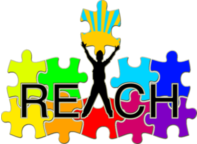
THE REACH Autism APPROACH
“By faith the walls of Jericho fell, after the people had marched around them for seven days” - Heb 11.30
Thank you for your interest in REACH Autism SA. Our organisation is aimed at empowering parents with information and the skills to help their children who learn differently.
Our approach is to focus on each child’s unique motivation, learning style and other factors affecting learning and self-esteem. We provide training, workshops and provide management of individualised education/rehabilitation programmes.
Jenny Buckle (founder and programme director) has identical triplet boys with autism. REACH Autism started out as workshop-based assistance for parents who wanted to learn how to help and understand their child with ASD. REACH has grown enormously since its inception in 2001 and we are now involved in the full-time management of home-based and/or school facilitation programmes.
At REACH Autism we use a ‘tailor-made’ approach to each child’s therapeutic process.
We use the principles of ABA (Applied Behaviour Analysis) to teach skills and modify/replace challenging behaviours. These behaviours are delayed/inappropriate in a child with ASD. Typically, the areas of difficulty for children with ASD are language and communication, socialization challenges, repetitive or stereotypic behaviour and sensory dysfunction. We also focus on the core deficits of social skills and experiences by teaching appropriate developmental levels using a play platform with child-led interaction.
It is important to identify each child’s motivational value system and teach within their area of motivation and interest. By doing so, we strengthen every great attempt and successful response a child makes. The child is learning all the necessary skills while engaging in preferred activities used as a platform to teach child specific goals.
We place an emphasis on teaching replacement behaviours while identifying the function of all inappropriate/challenging behaviours. We do not provide aversive therapy or use any form of punishment.
Providing constant prompting (help) to keep the child successful, high levels of reinforcement, and systematic fading of support has a powerful effect on all motivation and learning. Our adapted teaching methods are well suited to a child with ASD. Information is presented in a very specific and structured manner as often required initially when a child is unable to accurately discriminate the stimuli in the environment. Children with ASD have difficulty learning optimally in a dynamic (changing) environment and typical teaching methods are seldom effective. We fade the structured approach systematically and move to a ‘natural environment teaching approach’ as soon as possible.
While our therapy is a highly effective teaching approach, it should be implemented as part of a CHILD SPECIFIC, holistic and multi-disciplinary approach and effective therapy teams are essential. We work with other therapists and doctors to ensure a ‘whole therapy’ approach. Research has established that there are biomarkers in children with ASD that, when treated, significantly impacts the child’s ability to function and learn.
Autism is regarded as a neuro-immune disorder, and is no longer classified as lifelong and untreatable. It is essential to look at the underlying biological factors which may be contributing to an Autistic Spectrum Disorder. Biological and dietary intervention is a pivotal aspect of treatment for many children with ASD, where indicated. Further aspects of a multi-dimensional therapeutic approach may include sensory integration therapy, auditory integration training, speech/occupational/physio- therapy, primal reflex balancing, priming and facilitation at school, life/career skills training and many others.
We strive to provide a teaching approach that embeds a flexible child specific core of treatment within measurement and analysis (where data provides an absolute process of progress). Each child is recognised to have an individual learning style, sensory profile, brain profile and own sense of strengths and weaknesses. He/she has a unique combination of intellect, emotional, sensory and dynamic intelligences. He/she has the right to an optimal learning environment. It is possible for each child to be taught using all his/her senses, in a functional manner that encourages success, and increases internal motivation. Each child’s individualised education programme should focus on strengthening weaker areas, while embracing their giftedness.